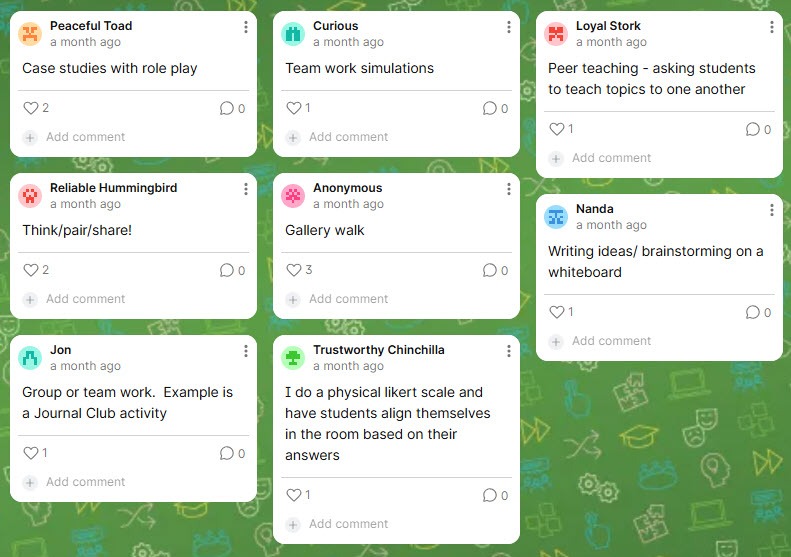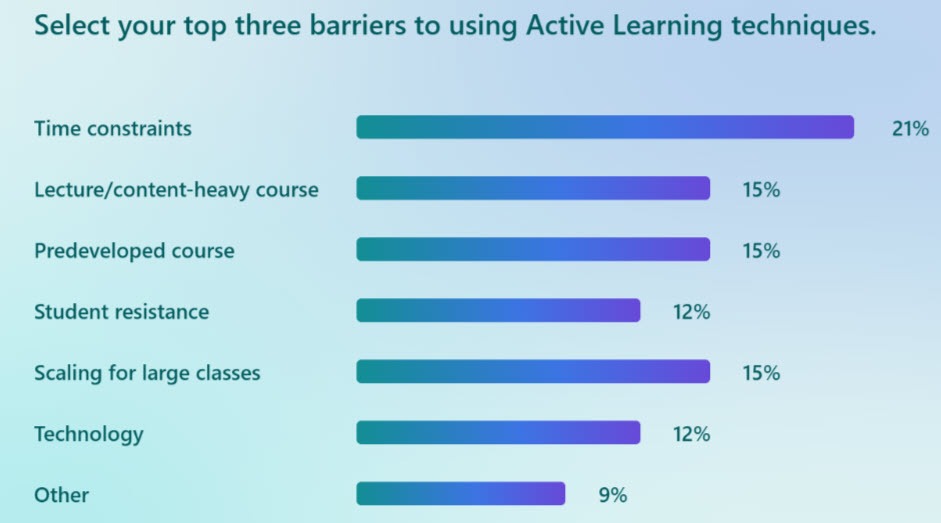On Monday, October 6, 2025, the Center for Teaching Excellence and Integration (CTEI) hosted a Brown Bag Lunch and Learn featuring the release of the Center’s Active Learning Cards and Online Resource. Caroline Egan, Teaching Academy Program Manager and Lecturer in the University Writing Program, developed the content and authored the cards. Beth Hals, Senior Instructional Technologist in the CTEI, created the online resource as well as the extension elements for each of the strategies. Both Caroline Egan and Beth Hals facilitated the session, which was hybrid, with both in-person and online participants.
Program Manager and Lecturer in the University Writing Program, developed the content and authored the cards. Beth Hals, Senior Instructional Technologist in the CTEI, created the online resource as well as the extension elements for each of the strategies. Both Caroline Egan and Beth Hals facilitated the session, which was hybrid, with both in-person and online participants.
Egan and Hals began the presentation by asking audience members why they might consider using active learning, which at a basic level is an evidence-based instructional approach that engages students directly in the learning process (Cavanagh, 2023). Audience responses included: engaging students, making classes more fun, and encouraging students to drive their own learning. Egan shared additional research about active learning, including how it improves learning and grades, reduces equity gaps, and lowers drop, fail, and withdraw (DFW) rates in STEM classes. She also noted that active learning can be used in any class modality (online, hybrid, in-person, etc.) and with any class size.
The session was very interactive, with Egan and Hals demonstrating the use of several active learning strategies throughout the workshop, pointing out the strategies used and explaining how they had been modified for a hybrid delivery format. For example, at one point, audience members were asked to think of a favorite active learning activity from a course, workshop, or training and post their responses to Padlet, an online collaboration tool used to creatively display visual content. This led to a lively share-out among audience members who were interested in hearing about their peers’ experiences with the strategies they shared, as well as interest in Padlet. Audience responses included: a gallery walk, think-pair-share, group work, brainstorming, case studies, peer instruction, stations, and a jigsaw activity.
This led to a lively share-out among audience members who were interested in hearing about their peers’ experiences with the strategies they shared, as well as interest in Padlet. Audience responses included: a gallery walk, think-pair-share, group work, brainstorming, case studies, peer instruction, stations, and a jigsaw activity.
Despite evidence-based support for active learning, Egan and Hals acknowledged that faculty sometimes face barriers during implementation. Using an online survey in Microsoft Forms, Hals asked audience members to select the top three barriers to using active learning. Survey results and suggestions for overcoming those barriers were then shared:
- Time constraints: Depending on the activity, active learning can sometimes take more time to plan and implement than a traditional lecture. A suggestion was made to start small; try incorporating one strategy into one lesson and build from there.
- Lecture/content heavy course: Faculty often feel pressured to cover vast amounts of content and feel that they won’t be able to cover everything if they implement active learning. Suggestions include using strategies to encourage reflection, rehearsal, or application of concepts and/or short knowledge checks throughout the semester to check for understanding.
- Predeveloped course: Faculty sometimes inherit a predeveloped course and don’t always feel comfortable making changes. A suggestion was made to have a conversation with others in the department or program, including their teaching and learning center, about how active learning might be integrated into the course and where there might be room for customization.

The second half of the session was dedicated to introducing the active learning cards and the corresponding online resource. The set of cards includes sixteen strategies, each with a description of an activity that can be used immediately or planned over a longer period of time. Each card also includes information about preparation time, student engagement time, debrief time, and whether the activity is best suited for individuals, pairs, or groups. The interactive online resource includes the information from each of the cards, as well as additional information about how to implement these strategies in different modalities, helpful tips, potential extensions or modifications, and recommended technology tools to support these strategies. Audience members were given plenty of time to review the cards and explore the online component before taking part in a few activities including a think-pair-share exercise and a small group activity.
The workshop concluded with the presenters sharing information on how to access the cards and online resource which are both available online from the CTEI website. The cards can be downloaded as a PDF or printed professionally in bulk by an external printing service (for a fee). If you are a JHU instructor or graduate student with teaching responsibilities, please feel free to drop by our center for a free set of cards or contact us at ctei@jhu.edu if you would like them mailed to you.
Amy Brusini, Senior Instructional Designer
Center for Teaching Excellence and Innovation
Image source: Lunch and Learn logo, Padlet, MS Forms, CTEI website
References:
Cavanagh, S. R. (2023, September 18). How to make your teaching more engaging. The Chronicle of Higher Education. https://www.chronicle.com/article/how-to-make-your-teaching-more-engaging/
